The Leesa and Casper are both very popular bed-in-a-box mattresses. When people hunt for a mattress online, odds are good that both of these beds will make an appearance in their search.
At first glance, it looks like the Leesa and Casper have a lot of similarities, but a closer look reveals they have some notable differences. Before shelling out cash for either of these beds, give this comparison a read. In this Leesa vs Casper mattress comparison we’ll analyze the construction and feel of both mattresses and highlight which kind of sleepers might prefer which bed.
Leesa vs Casper Side-by-Side
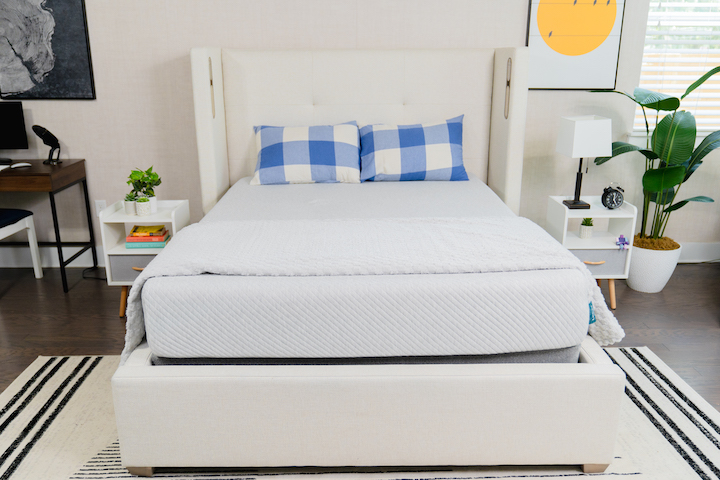
|
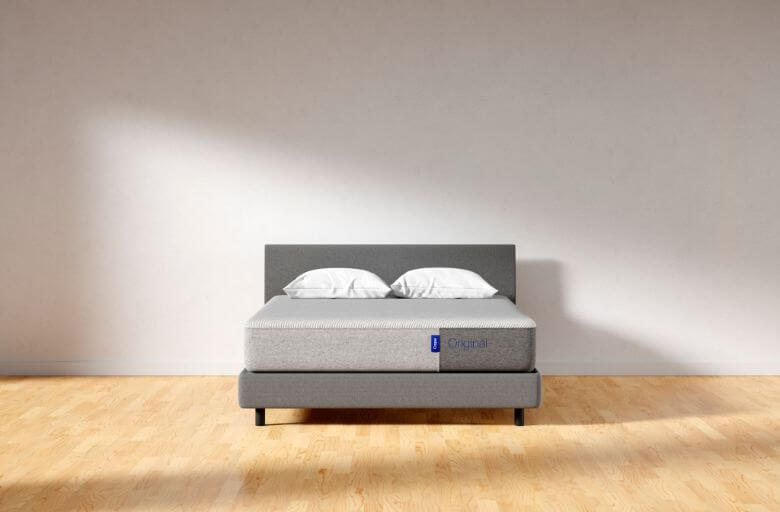
|
|
| Leesa Original Mattress | Casper The One Mattress | |
| Rating | ||
| Firmness | Medium-firm: 6.5/10 | Medium-firm: 7/10 |
| Material | Foam | Foam |
| Cooling | — | — |
| Best For |
Side Sleepers,
Back Sleepers, Stomach Sleepers |
Back Pain,
Seniors, Couples |
Leesa And Casper Mattress Overview
The Leesa and Casper are popular mattresses sold online. The Leesa is an all-foam mattress that does a nice job of staying cool. The all-foam Casper features a Zoned Support system that offers a unique balance of comfort and support. These beds have some similarities as well as different feels that will appeal to different types of sleepers – let’s take a closer look:
| Who Should Choose the Leesa? | Who Should Choose the Casper? |
| Lightweight back sleepers looking for a balance of comfort and support | Combination sleepers looking for a balance of comfort and support in multiple positions |
| Light and medium-weight side sleepers who want pressure relief around the shoulder and hips | Back sleepers who require extra lumbar support from their mattress |
| Mattress shoppers who are looking for the best cheap mattress | Larger people who need some extra overall support and firmness |
Leesa vs Casper Mattress Video Comparison
Want to take a closer look at how the Leesa and Casper compare? Check out our in-depth video review below – our reviewer, Marten, will assess the mattresses’ constructions and share his experiences with both.
Leesa vs Casper: Similarities and Differences
There’s a reason the Leesa and Casper often show up alongside each other when folks search for mattresses online – these beds have several factors in common. However, they aren’t entirely identical. Let’s look at the similarities and differences between the two.
| Similarities | Differences |
| The Leesa and Casper are both all-foam mattresses. | In our experience, the Casper mattress feels firmer than the Leesa. |
| They both feature memory foam somewhere in their construction. | The Casper has a zoned construction, while the Leesa mattress does not. |
| They have a similar base layer on the bottom. | The Leesa mattress costs a bit less than the Casper. |
| The Leesa mattress and Casper both have a balanced foam feel. | The Casper is a bit thicker than the Leesa mattress. |
Firmness And Feel Differences
The Leesa and Casper have some similarities when it comes to firmness and feel, but these will depend on the weight and preferences of the sleeper in question.
How Firm Are The Leesa And Casper Mattresses?
We ranked the Leesa around a 6.5/10 on the firmness scale, and we found the Casper to be a 7/10. The industry standard for medium firmness is 6.5, so this means the Leesa is around medium firm and the Casper is just a touch firmer than that.
That said, the perception of any mattress’s firmness can change depending on a person’s weight, so keep in mind that this measure is somewhat subjective.
Sleeping On The Leesa And Casper Mattresses
Now, let’s talk about what it felt like to sleep on the Leesa and Casper mattresses:
Leesa
While back sleeping on the Leesa, we experienced good overall support. The foam pressed up into our lumbar area to help maintain healthy spinal alignment, and we also felt a decent amount of contouring for pressure relief.
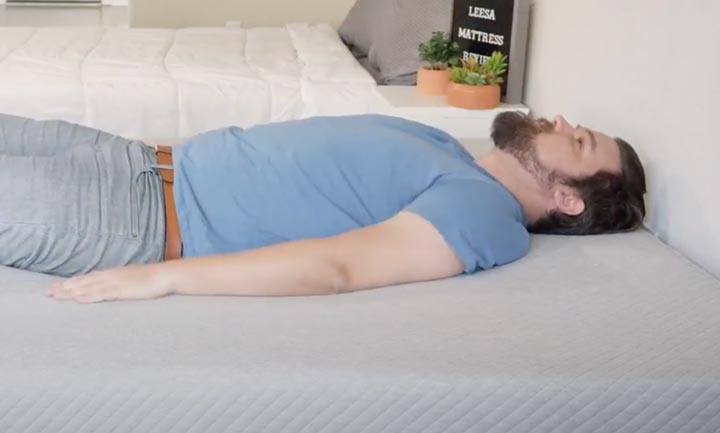
Moving to our side on the Leesa, we pressed into the mattress’s layers but didn’t feel like we were bottoming out. We felt good pressure relief around the shoulders and hips. (Note that folks who are very heavy might have a different experience.)
We found the Leesa to be too soft for stomach sleeping – our hips bowed into the mattress, which caused some lower back strain. Lighter-weight folks might have a better experience on the Leesa, but those who need the best mattress for stomach sleepers will probably need a firmer bed.
Casper
While back sleeping on the Casper, we felt great support around the hips and the lumbar area. Because the hips didn’t sink in too far, our spines stayed aligned — that’s crucial for avoiding back pain. It’s no surprise that the Casper is one of the best mattresses for back sleepers.
Moving to our sides, we felt a touch of pressure relief combined with plenty of support from the Zoned Support system. Heavier folks might find that the mattress feels too firm in this position, while lighter-weight people will probably feel more pressure relief. Find more beds for combination sleepers here.
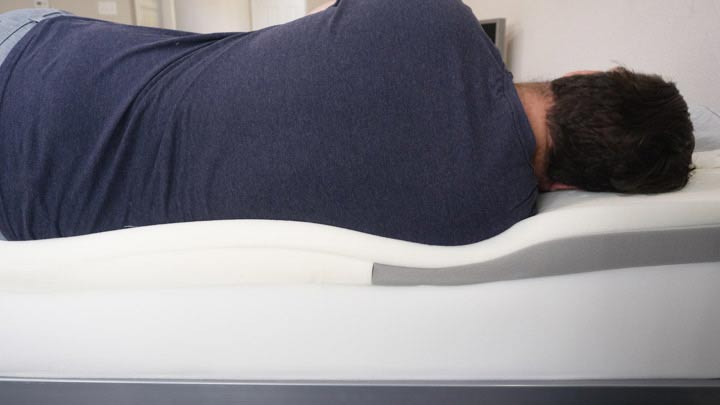
In our experience, the Zoned Support system offers decent support while stomach sleeping. That said, people who spend all night on their stomachs might be better off with a firmer mattress that’s designed for stomach sleepers.
What Do The Leesa And Casper Mattresses Feel Like?
The Leesa mattress has a balanced foam feel – the soft memory foam in the second layer has some of the slow-moving feel of classic memory foam, but the mattress is still fairly responsive.
The original Casper mattress has a bouncy, responsive foam feel – these qualities make it easy to move around on the mattress. The Zoned Support system is designed to provide support where it’s most needed (to maintain spinal alignment) while offering pressure relief around the shoulders.
Average Weight Sleepers – 130 lb – 230 lb
For average weight back sleepers, the Leesa does a nice job of providing both pressure relief and spinal support. When it comes to side sleeping, the Leesa should provide decent pressure relief around the shoulder and hips. (But for people on the higher end of the weight spectrum, it might feel too firm.) The Leesa is probably not firm enough for average weight stomach sleepers.
The Casper should be a good fit for average weight back sleepers because it offers a nice balance of comfort and support in this position. It’s also a nice mattress for side sleeping; the Zoned Support System provides spinal support along with pressure relief around the shoulder. The Zoned Support System could also provide decent support for average weight stomach sleepers who don’t want their hips to bow into the mattress.
Heavyweight Sleepers – Over 230 lb
In general, the Leesa is probably not a great fit for most heavyweight sleepers. There’s a chance it might offer enough support to heavier back sleepers, but it won’t provide enough pressure relief to side sleepers or enough support to stomach sleepers.
On the other hand, the Casper’s Zoned Support System provides extra spinal support, so heavyweight back sleepers could find adequate support on this mattress. However, heavyweight side sleepers probably won’t find enough pressure relief on this mattress. Heavyweight stomach sleepers on the lower end of the spectrum might find enough support, but odds are good that they’ll need to find a more supportive mattress.
Lightweight Sleepers – Under 130 lb
The Leesa could be a nice match for lightweight back sleepers because it offers a blend of comfort and support in this position. It’s also a nice fit for side sleepers who are looking for plenty of pressure relief on their shoulders and hips. While strict stomach sleepers will probably want a firmer bed, the Leesa might be supportive enough for some super lightweight stomach sleepers.
The Casper should be a good fit for lightweight sleepers of all stripes. It offers a nice mixture of comfort and support while back sleeping, and it also features decent pressure relief for side sleepers. In addition, the Zoned Support System could make this mattress supportive enough for lightweight stomach sleepers. It is actually one of our top picks for the best mattress for lightweight sleepers.
Mattress Construction Differences
Now that we have a sense of the similarities and differences between the Leesa and Casper, let’s look more closely at how these beds are constructed.
Leesa
| Layer | Description |
| Cover | The Leesa’s breathable cover is made of a soft twill fabric. |
| Comfort Layer #1 | The Leesa’s top comfort layer features 2″ of something called LSA200 foam; this proprietary foam is very soft, comfortable, and surprisingly responsive. It is also more breathable than other types of foam (especially memory foam). |
| Comfort Layer # 2 | elow the LSA200 foam, there are 2″ of conventional memory foam which provides body contouring and adds more pressure relief to the top of the mattress (around the shoulders). |
| Support Layer | The Leesa mattress’s support layer is made from polyfoam, which is firm, durable, and supportive – this base layer offers overall support to the mattress. |
Casper
| Layer | Description |
| Cover | The Casper features a soft, breathable cover that’s made from recycled bottles. |
| Comfort Layer #1 | The Casper’s top comfort layer is made from proprietary Airscape foam; it’s perforated, which allows for more airflow and makes this more breathable than conventional memory foam. |
| Comfort Layer #2 | Beneath the Airscape foam, there’s the main feature of the Casper: the Zoned Support System. This is a layer of memory foam that’s firmer near the center and softer near the head and foot of the mattress. The idea is to make the bed firmer and more supportive for back and stomach sleepers while providing more pressure relief around the shoulder when side sleeping. |
| Support Layer | The Casper mattress’s base layer is also made from polyfoam, which is firmer than the foams above it. |
Mattress Height
The Leesa is 10″ tall, while the Casper is just a touch thicker at 11″ tall.
Leesa And Casper Mattress Size Options And Price
Check out the following charts for the most up-to-date sizing and pricing info for both the Casper and Leesa mattress.
Leesa
| Size | Dimensions | Price |
| Twin | 39″ x 75″ | $849.00 |
| Twin XL | 39″ x 80″ | $899.00 |
| Full | 53″ x 75″ | $1099.00 |
| Queen | 60″ x 80″ | $1299.00 |
| King | 76″ x 80″ | $1599.00 |
| California King | 72″ x 84″ | $1599.00 |
Casper
| Size | Dimensions | Price |
| Twin | 39″ x 75″ | $895.00 |
| Twin XL | 39″ x 80″ | $995.00 |
| Full | 53″ x 75″ | $1195.00 |
| Queen | 60″ x 80″ | $1295.00 |
| King | 76″ x 80″ | $1695.00 |
| California King | 72″ x 84″ | $1695.00 |
See how these prices stack up to other mattress brands in our other popular Leesa and Casper comparisons like Leesa vs Tempur-Pedic and Casper vs Puffy.
Product
Firmness
Score

Product
Firmness
Score

Product
Firmness
Score
Leesa Vs Casper Performance Differences
We put the Leesa and Casper mattresses through several tests to see how they perform with cooling, motion transfer, edge support, and other factors – let’s see how they did!
Sleeping Hot Or Cold
It is pretty much a tie when are speaking about cooling and heat dissipation. Both mattresses use more breathable foams in their top comfort layers, which makes these beds a touch less hot than some more conventional memory foam mattresses.
Motion Transfer
This one is a close call; because both mattresses feature memory foam in their second layer, they both do a decent job of cutting down on motion transfer. (Memory foam is known for absorbing movement and keeping couples from disturbing each other at night).
RELATED: Best Mattresses for Couples
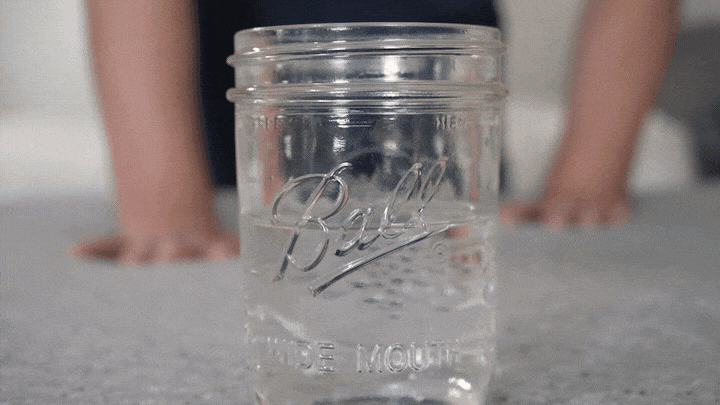
Edge Support
The win here goes to Casper – we felt more secure while sitting and lying down near the edge of this mattress. That’s probably because of the Casper’s Zoned Support System, which makes the bed a little firmer and more supportive overall.
Durability
This is another tie, since both mattresses are all-foam mattresses and boast similar life expectancies. The Leesa and Casper should each last for around 7 years.
Off-Gassing
In our experience, there wasn’t a notable difference in off-gassing between these two mattresses.
Noise
Once again, the Leesa and Casper performed about the same, and we didn’t experience any notable noise from either mattress.
Sex
When folks are looking for good mattresses for sex, they’re usually worried about whether they’ll feel stuck in the bed. Both the Leesa and Casper are responsive foam mattresses, which makes it easy to move around.
Warranty Info
Both the Leesa and the Casper come with a 10-year warranty and a 100-night sleep trial.
Product
Firmness
Score

Product
Firmness
Score

Product
Firmness
Score
Leesa And Casper Mattress FAQs
Still have questions? Check out our answers to some of the most frequently asked questions about the Leesa and Casper.
Which mattress is better, Leesa vs Casper?
Neither mattress is inherently better than the other, but each one is likely to be a better fit for different types of sleepers. The Leesa is a nice match for lightweight back sleepers, light and medium-weight side sleepers looking for pressure relief around the shoulder, or mattress shoppers who are looking to save a little bit of money. The Casper is probably a better fit for combination sleepers, back sleepers, and larger people, who need some extra support.
Which mattress is more affordable, the Leesa or Casper?
The Leesa costs about $100 less than the Casper, which makes it just a touch more affordable.
Which mattress is better for side sleepers, the Leesa or Casper?
Based on our experience, the Leesa is the softer mattress. This means it should provide plenty of pressure relief for side sleepers, who don’t want to feel jammed up around the shoulder. That being said, the Casper also offers decent pressure relief for side sleeping.

